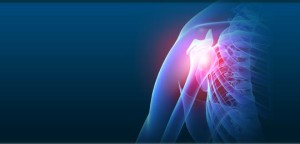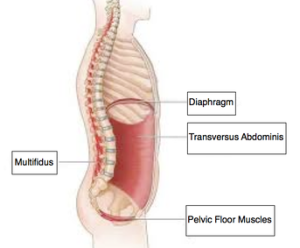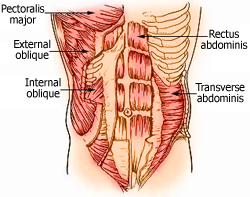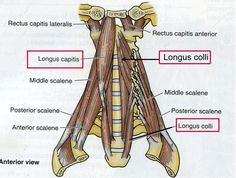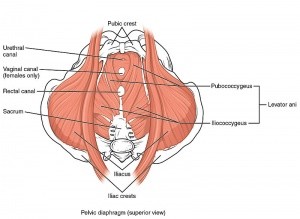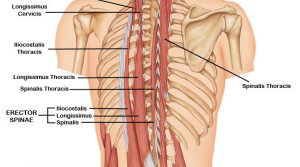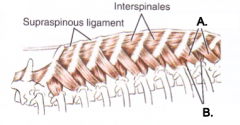Basic Concepts:
Joint functional centralization
- Joint surface (socket and ball) are should be in maximal contact to each other to avoid other forces, for example cutting forces, which can cause overloading or even damaging of the articular capsule.
- Joint stabilizing muscles which are causing the movement have in the centralized position of the joint the most advantageous conditions for work. The center oriented force vectors are supporting stabilization of the joint itself. We use the word ‘centralization’ and/or centered-stabilization exercising.
- The stabilizing forces produced by group of muscles around the joint are also important. Independent to the anatomical classification. The motor units of different muscles are generating the functional stabilization unit. Hypothetically we suggest, that more units are solving either the centered-stabilization or mobile We can simply say that the stabilization of the joints is reached in case of cooperation of two antagonists muscles / like ropes holding a pole.
- We can consider the signals leaving the centralized (physiologically adjusted) joints and coming to the brain as the physiological, healthy and correct. We also assume that the brain response (like the selection of the way of muscle control or start of the stabilization programs) to the physiological joint alignment will be the physiological.
The joint condition
The joint condition is essential for our motion, it is limiting us in the similar way as the condition of the circulatory, nervous, digestive, immune system and others. The joint condition depends on the delivery of energy, metabolism, state of involved tissues (cartilages, fascia or muscles) and also on the level of the central nervous system CNS.
You can notice the influence of CNS by the actual joint alignment almost instantly. As the proof would serve us therapy by centralization of shoulder. After couple of minutes using manual pressure on the humerus into the shoulder socket, you can see as a result relaxation of the upper scapula fixators but also other hyperactive muscles, which are located out of the shoulder region for example lumbar erectors. The joint alignment into the central position using adequate pressure you will influence the CNS which starts normative tonus of number of motor units. This will basically make the exercising easier to learn.
From the long term aspect point of view it is also applies that if you will continue exercising with the attention to the centralized joint settings, you will also influence the CNS habits that means you will change stabilization and movement stereotypes.
Our goal is to learn the correct joint alignment in the gym and transfer these practice into the daily life. Together with change of joint hold the tissues changes itself as well. It is well known that during the centralized joint settings the compact muscles around joint is being built, however this also influences ligaments and logically we can assume also the cartridges and bones.
The concept joint condition includes not only the ability of reaching the centralization and stabilization of joint, but also the ability set the joints into this position under various loads and conditions even in situations never examined.
The muscle tonus
The quantity of muscle tension, muscle tonus is responsible not only for the movement but also for the joint stabilization. When it is optimal we call it norm tonus. If it is out of norm we call it hyper tonus / too much of a tension or hypo tonus / insufficient tonus. Abnormal muscle tonus is also a sign of possible nervous system disorders. The solution for neurologic disorders is not a subject of these web pages even though we can support the treatment by implementing suitable exercises.
In the gym we try to influence stabilization and motion stereotypes. The muscle tonus is the part of not only stabilization but also dynamic ^&*(motion) motor units, muscle fascicles, part of muscles and the muscles as unit itself. We can optimize the muscle tonus in the gym which we call muscle toning. We will speak about manual perceiving of the muscles / palpation. Based on this diagnostic we purposely suppress or intensify the hyper tonus. By model joint configuration practice, breathing method, un-stressing of segments or resistance against the motion – strength training, but also by post-isometric relaxation and stretching, by this all we influence conscious and unconscious processes of the CNS, we optimize the muscle tonus, impact positively on the health of our joints.
Joints and the stabilization system
Imagine the joint as a mechanical slippery bearing, which has to be tighten no to be too loose and not to get damaged. We can compare it to adjusting of the bearing on a bicycle- if you will tighten it too much, it will make it difficult to ride and if they would be to loose, it would break apart. With our joints it is the same in our bodies, it has to transfer the motion and at the same time it has to be stable. Before the motion will start our brain has to secure the joint stabilization to make sure they won’t get damaged by the motion itself. We know already for decades, that during the dumbbell front raises we first engage the stabilization muscles of our spine, abdominal muscles, back muscles and only then we activate muscles raising the arm / mainly the deltoids.
Authors Hodges and Richardson (1996) have discovered that people suffering from back pain have delayed activation of deep abdominal muscles – even in the times when they do not feel the back pain at the moment. That means that if we want to avoid back pain we should first learn how to stabilize spine before the motion starts.
If we want to keep our joints safe, we have to support “the function of the deep stabilization system.
If we will simplify the stabilization and human motion, we can speak about framework which has all the driving systems and transitional mechanisms attached to it. The car has chassis to which the car body is attached together with wheels, engine, etc…. The chassis has to be really stout to be able to resist huge forces between engine and wheels. Human does not have stationary framework and also does not have only the primitive function of drive. It has to perform also the function of excavator, crane, manipulator with weight and many other including social and communication functions.
The human chassis has to be created by our central nervous system during every situation over again. At its disposal it has bones, joint and its components (capsules, meniscuses, ….) and tendons. And of course muscles together with the brains programs.
The muscle stabilization system can be also compared let’s say to ropes of a pole (considering our vertical aspect). When the pole is tilted to one side we can make it even by losing the ropes on one side and tightening the ropes on the other. But if a strong wind will start blowing or if we want to fasten something to the pole, we have to in addition tighten everything on both sides.
How is it in case of humans? If we are standing lopsidedly, we activate pulling activity of the muscles on one side, we will align the stand. If there is a posture disproportion caused for example by ankle injury the result can be tilted pelvis, increased activation of muscles on one side of the body, which will follow with disproportions of other body parts up to the head. We can then observe wrong posture which is causing other issues like pain of the neck spine or headaches. This is only natural response of the body, which is trying to keep horizontal level of eyes and stabilization.
What lessons are we learning from this? To také care of the stabilization system and seek for the roots of the disorders in whole body, not only in the areas, where we feel the pain. When we have to resist larger outer forces, we increase the tension of motor units, which are forming the stabilization system itself. This works as per the regularities which summarize under the “law of stabilization synergy”: the bigger are the requirements on stabilization the more is the system of the stabilization motor units active, it must work harder and cooperate.
On the other hand, if we only stand without a load, we switch off part of the stabilization motor units. The classic example would be African women carrying crocks of water on their head. Their posture is even more exemplary, regal and more upright at the same time. The stabilization muscle chains and joints are adjusted into the central stabilization position. After taking off the crock the body behaves more casually. Another example would be the physician medical checkup where we are trying adjust our body in to the position “how it supposed to be”, not how it we stabilize ourselves under the load by nature.
In our motion behavior we can find voluntary and involuntary influences.
Let’s get back to our body and its function in term of the work of muscles and their coordination. Part of the muscles responsible for the motion (mobility system) is working according to a different system than the stabilization one. If I want to pull a barbell to my shoulders, I have to educe quite a big force by biceps of the arm. On the opposite side of biceps there is triceps which is operating the elbow joint in the opposite direction. If it would be too flexed, it would inhibit the work of biceps. In principle it explains the law known from neurology as antagonist reciprocal inhibition, which means inhibition of the muscles positioned on the other side of the joint and muscles causing the movement.
In other words, the larger forces we want to reach, the larger muscle tension of the active muscles we have to create. On the other hand, the less the movements should be hindered by the antagonist muscles. In order for the stabilisation and the motion system to be in harmony, both of the systems have to cooperate. Just like two controlling departments in the brain would control certain type of the motor units. The first type forming the stabilisation system will have tendency to hold the joints together. On the contrary – motor units responsible for the movement – will tend to releasing and getting rid of any resistance. In order for the body to manage this, there have to be certain programs in the brain, which are used for known situations. If it is trying to create programs for new situations, this takes longer time.
Sometimes these two systems are not aligned and the motion system will start providing the stabilization function instead of the motion. One of the examples can be back ache caused by overloading surface erector muscles.
Surface erector muscles have to substitute the job of deep stabilization muscles during wrong stabilization.
In the physiotherapy there is used a type of treatment, which involves manual centralization of the joints and this way the stabilization physiological programs can be started. For example, treatment of motion disorders external inducing of the joint and gentle push to the joint. This way we can restart the flow of the centripetal physiological information, which are processed by the brain and initialize the physiological programs. Basically you will unblock the basal programs and subprograms.
By adjusting the joints into the function centralization using adequate strength action and cooperation with the trainee we can support the physiological processes. All is under the supervision of the brain.
The Deep stabilization system of the Spine / DSSS
Our first goal during the exercising is stabilization of the backbone, that is why we will present it in a detail even though we are aware of stabilization of the shoulder blade and the key joints – shoulders, hips – which participate in this function as well.
The Deep stabilization system of the spine / DSSS includes the following muscles:
- Diaphragm
- Deep abdomen muscles / m. abdominis transversus, m. obliquus internus abdominis
- Deep spine muscles / rotators, erector spinae, m. multifidus, …
- Deep flexors of neck spine
- Muscles of pelvic floor
Apart from the deep muscles located in the direct location of the spine is the DSSS directly influenced (formed) by next muscles, for example by the muscles of chest. Intercostal muscles and for example transversus thoraces are adjusting the position of ribs and breastbone and this way acting upon the chest spine. The ribs are forming big level, which can be easily hurt. They are influenced by the spine erectors – for example the m. iliocostalis. One small change on one side of the rib will be transferred on the other end of the rib, on the spine or onto the breastbone. And as we know ribs are connected with diaphragm, abdominal muscles and other muscles influencing the spine. In short our spine is apart from DSSS stabilised by a number of other muscles.
These are laid medium deep and they are hard to be reached by touch and hardly influenced by conscious mind. Good example is the loop or chain – serratus posterior inferior connected to m. iliopsoas.
The stabilisation of spine is provided also by the superficial muscles. However, there could be impendency of overlooking the deep muscles and concentrating only on the superficial ones. That is why we see urgency even in the gyms, not only on the rehabilitation workplaces, to attend to the DSSS. We will discuss training of the DSSS further during the posts.
The fundamental components of DSSS
Diaphragm: in order to work in the stabilization way, other muscles have to create the right conditions for it., stabilize its insertions. If not done so, diaphragm will function only as the breathing muscle. Just so by new-born. Diaphragm has many insertions and if there is a dysfunction by one of them, then it does not work evenly, the full stabilization of a certain section is missing. So further on we will discuss the matter and work of diaphragm.
The deep abdominal muscles – securing stabilisation we can train during exercising with strength exhale but also with the inhale – but that one is not strength as we will see later.
The deep neck flexors – during the exercising it is advisable to push your head with the vertex upwards and this way exercise these muscles.
Muscles of the pelvic floor – they are even more tributary to our subconscious and their functional training is necessary, however difficult. That is why you can see so many mistakes during its training.
The Rotation and erector muscles – their training does not occur during rotation movements, but also during for example unilateral exercising, which is supported by the diagonal tension of the trunk muscles.
The greater forces are generated and the greater range of motion is reached, the more muscles close to the surface are engaged. That is why at the beginning of the drill it is important to put up a smaller resistance and the range of motion has to be shorter in order to learn how to activate the DSSS. Gradually the cooperation of the deep and surface muscles is reached.

